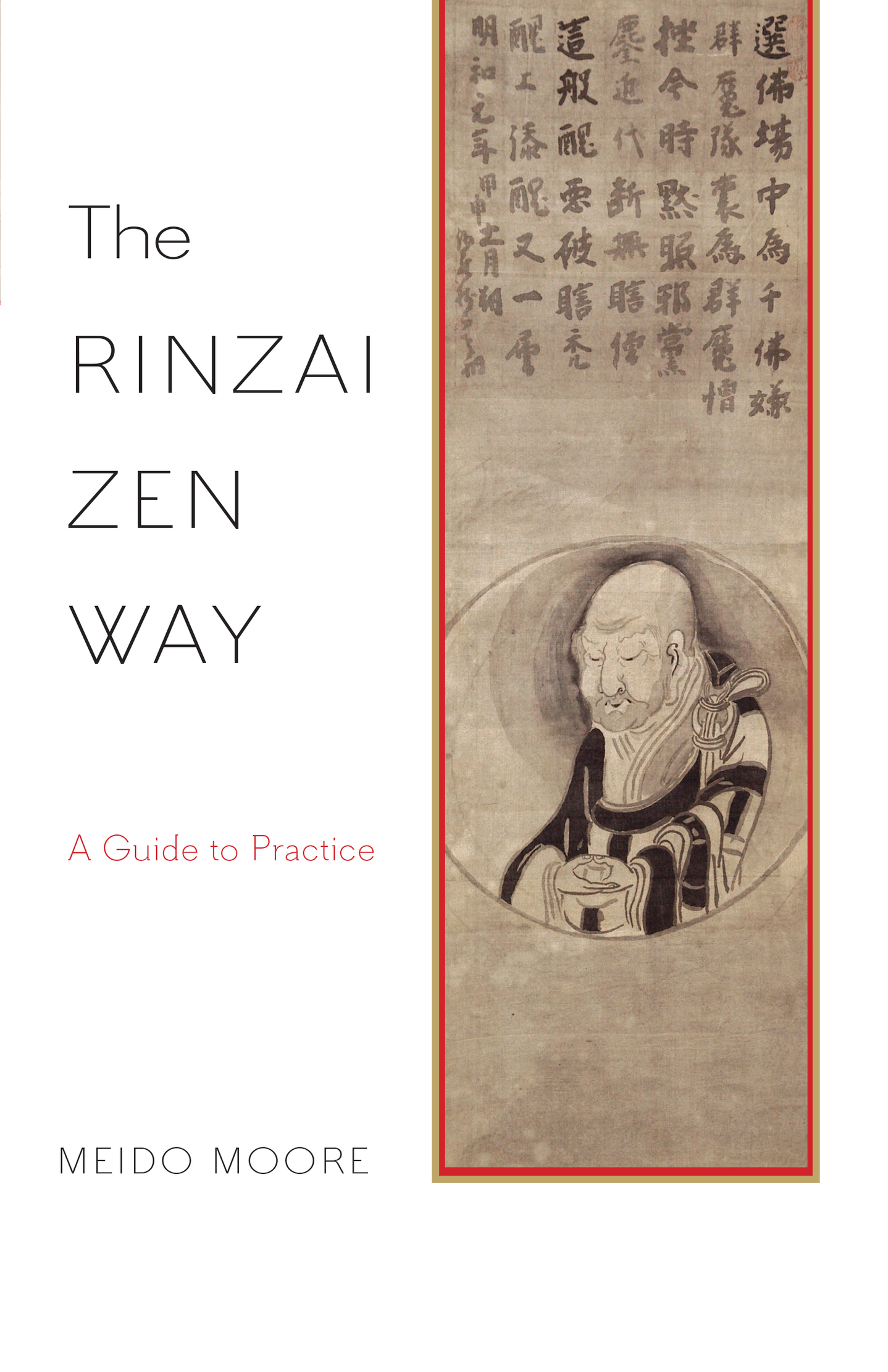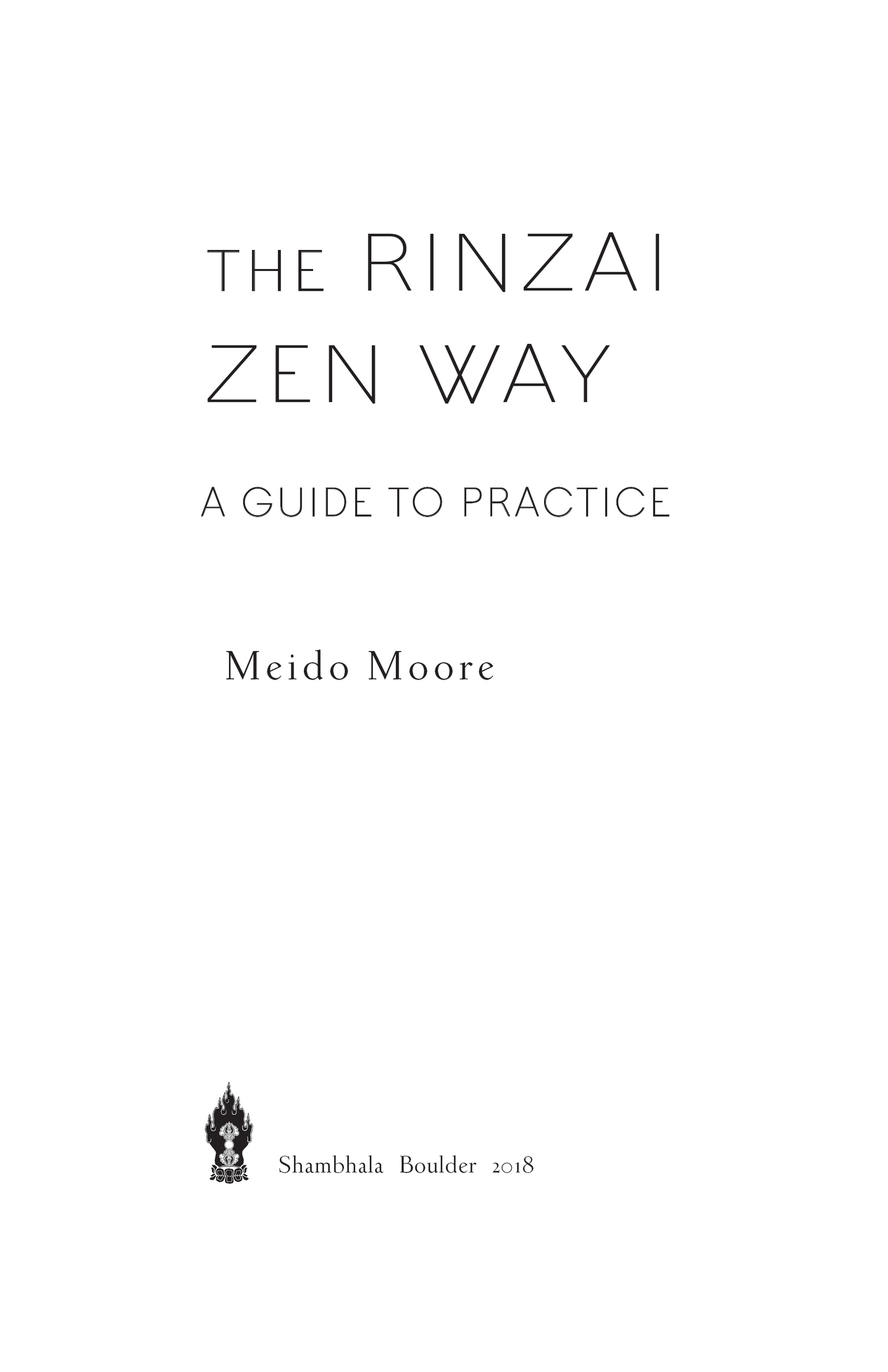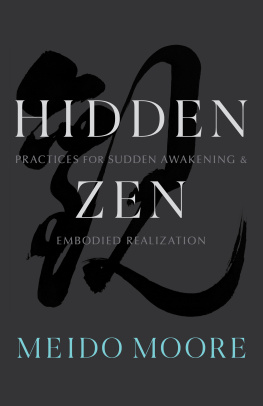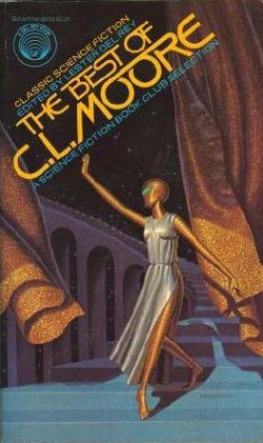Meido Moore - The Rinzai Zen Way: A Guide to Practice
Here you can read online Meido Moore - The Rinzai Zen Way: A Guide to Practice full text of the book (entire story) in english for free. Download pdf and epub, get meaning, cover and reviews about this ebook. year: 2018, publisher: Shambhala, genre: Religion. Description of the work, (preface) as well as reviews are available. Best literature library LitArk.com created for fans of good reading and offers a wide selection of genres:
Romance novel
Science fiction
Adventure
Detective
Science
History
Home and family
Prose
Art
Politics
Computer
Non-fiction
Religion
Business
Children
Humor
Choose a favorite category and find really read worthwhile books. Enjoy immersion in the world of imagination, feel the emotions of the characters or learn something new for yourself, make an fascinating discovery.

- Book:The Rinzai Zen Way: A Guide to Practice
- Author:
- Publisher:Shambhala
- Genre:
- Year:2018
- Rating:5 / 5
- Favourites:Add to favourites
- Your mark:
- 100
- 1
- 2
- 3
- 4
- 5
The Rinzai Zen Way: A Guide to Practice: summary, description and annotation
We offer to read an annotation, description, summary or preface (depends on what the author of the book "The Rinzai Zen Way: A Guide to Practice" wrote himself). If you haven't found the necessary information about the book — write in the comments, we will try to find it.
Meido Moore: author's other books
Who wrote The Rinzai Zen Way: A Guide to Practice? Find out the surname, the name of the author of the book and a list of all author's works by series.
The Rinzai Zen Way: A Guide to Practice — read online for free the complete book (whole text) full work
Below is the text of the book, divided by pages. System saving the place of the last page read, allows you to conveniently read the book "The Rinzai Zen Way: A Guide to Practice" online for free, without having to search again every time where you left off. Put a bookmark, and you can go to the page where you finished reading at any time.
Font size:
Interval:
Bookmark:


Bodhidharma, the First Zen Patriarch. Kensho Jobutsu:
Seeing [ones true] nature, becoming Buddha
Painting and inscription by Dogen Hosokawa Roshi.

Translation of Hakuins poem inscribed on the cover painting:
In the realm of the thousand buddhas
He is hated by the thousand buddhas;
Among the crowd of demons
He is detested by the crowd of demons.
He crushes the silent-illumination heretics of today,
And massacres the heterodox blind monks of this generation.
This filthy blind old shavepate
Adds more foulness still to foulness.
Miura, Isshu and Ruth Fuller Sasaki. Zen Dust: The History of the Koan and Koan Study in Rinzai (Lin-Chi) Zen. New York: Harcourt, Brace & World, 1967.
Shambhala Publications, Inc.
4720 Walnut Street
Boulder, Colorado 80301
www.shambhala.com
2018 by Meido Moore
All rights reserved. No part of this book may be reproduced in any form or by any means, electronic or mechanical, including photocopying, recording, or by any information storage and retrieval system, without permission in writing from the publisher.
Cover design by Jim Zaccaria
Cover art: Hakuin Ekaku (16831768), self-portrait. Used with permission from Eisei Bunko Museum.
L IBRARY OF C ONGRESS C ATALOGING-IN -P UBLICATION D ATA
Names: Moore, Meido, 1968 author.
Title: The Rinzai Zen way: a guide to practice / Meido Moore.
Description: First edition. | Boulder: Shambhala, 2018.
Includes bibliographical references and index.
Identifiers: LCCN 2017027218 | ISBN 9781611805178 (pbk.: alk. paper)
eISBN9780834841413
Subjects: LCSH : Spiritual lifeRinzai (Sect)
Classification: LCC BQ 9389.5 . M 66 2018 | DDC 294.3/444dc23
LC record available at https://lccn.loc.gov/2017027218
v5.2
a
S HAKYAMUNI B UDDHA turned his eye inward, realized his True Self, and set in motion the wheel of the dharma. In the twenty-some centuries since, the many schools of Buddhism developed, all of them centered on this fundamental experience but varying in their modes of expression and techniques of training.
The Zen school began in China, starting from the sixth century C.E. Zen emphasizes the primacy of realization and the necessity of continued refinement of that experience. Even within Zen, different styles of expression developed. The school of Zen associated with Rinzai (d. 866) is known for its dynamic style and its emphasis on the body: all activity can be meditation; wisdom must manifest in every action of the realized person. The Rinzai school became the dominant school of Zen in China, and was eventually transmitted to Japan.
Our line of Zen was transmitted to the West by Omori Sogen Roshi, one of the foremost Japanese Rinzai Zen masters of the twentieth century. He once expressed his understanding of Zen in these words:
Zen is to transcend life and death (all dualism), to truly realize that the entire universe is the True Human Body through the discipline of body-mind in oneness.Zen without the accompanying physical experience is nothing but empty discussion.
Drawing on his own background, Omori Roshi developed a distinctive manner of training in Zen that can be summed up (in Japanese) as Zen ken sho. Zen stands for traditional training in Rinzai Zen, including meditation and related practices. Ken means sword and stands for the use of physical trainingin Omori Roshis case, martial artsto develop energy and dynamic use of the body and breathing. Sho means brush and stands for the fine arts; in the context of our training, it means to develop refinement and sensitivity. All these activities are the discipline of body-mind in oneness. All these can be the manifestation of wisdom in action.
In this book, Meido Moore introduces the fundamentals of Rinzai Zen. provides an overview of training in Zen. It locates Zen within the larger landscape of Buddhist practice, and presents the distinctive Zen approach to the motivations for undertaking training, the role of compassion, the nature of enlightenment and its manifestation, and connection between the physicality of training in Zen and the meditative states usually associated with Buddhism.
gives practical instruction in the basics of Zen training in a manner suitable for beginners. Zen training is difficult to accomplish without direct instruction from a knowledgeable teacher. Moore Roshi has provided a detailed and accessible introduction to the use of the body, breath, and mind in meditation that can be fruitfully followed on ones own. He introduces the important practice of training in daily life; even the simplest activities provide the opportunity for training, and to begin these practices is to enter the practice of Zen. Finally, because progressing on the path requires instruction and correction, the text concludes with discussion of the role of a Zen teacher, selecting a teacher, and working with a teacher.
Though Zen has now spread widely, it is clear that modern students often lack an understanding of Zens physicality and the embodied nature of Zen realization. The thread of bodily realization is in danger of being lost. Without this, Zen easily becomes the empty discussion about which Omori Roshi warned. For this reason, it is important that the Rinzai approach to Zen practice that Omori Roshi transmitted be clearly explained and more widely known.
I therefore hope that beginners will make use of this book as an entrance into correct Zen practice, thus avoiding mistaken steps on the path. Further, I hope that practitioners of any levelin any lineagewill use it to clearly see both the strong and weak points in their training.
S O ZAN M ILLER
Abbot, Daiyuzenji Rinzai Zen Temple
Chicago, Illinois
A Z EN B UDDHIST LINEAGE descended from the Chinese master Rinzai Gigen (Linji Yixuan, d. 866) was first transmitted to Japan in a lasting way by Myoan Eisai (11411215). From that time onwardand with patronage from the ruling warrior class and imperial familythe Rinzai Zen school became well established. In particular, the great cultural and spiritual flowerings of the Japanese medieval period were largely centered in Rinzai monasteries.
Of the various Rinzai lines that eventually arrived in Japan, the vital Otokan* lineage alone survives to the present day. This was the lineage inherited by Hakuin Ekaku Zenji (16861768), who revived Rinzai Zen from a period of decline and organized the path of training into its present form. Today, all existing Japanese Rinzai lineages can be traced to that preeminent master.
A few of those lineages have now taken fragile root in the West. We may therefore say that we are witnessing another crucial stage of Rinzai Zen transmission, perhaps as crucial as that from China to Japan. Unfortunately, at this time there are few original works by Western authors that are useful for beginners desiring to actually practice Rinzai Zen. Certainly nothing in the West can yet match works such as Omori Sogen Roshis Sanzen Nyumon
I, too, am unable to author anything matching those earlier works. But I believe that a short book for beginners primarily stressing actual practice details from a Rinzai Zen perspective might be useful. I therefore began writing this book with my students in mind, hoping simply to address points of practice that easily go awry. Recently, however, I have been often contacted by distant persons asking how they also may start to practice Rinzai Zen. Of course, practice instructions are ideally received from a living teacher, face-to-face, and that relationship remains indispensable. Yet those who have not yet found a teacher can still begin in a limited way. Providing guidance for such people might thus be another use of this book.
Font size:
Interval:
Bookmark:
Similar books «The Rinzai Zen Way: A Guide to Practice»
Look at similar books to The Rinzai Zen Way: A Guide to Practice. We have selected literature similar in name and meaning in the hope of providing readers with more options to find new, interesting, not yet read works.
Discussion, reviews of the book The Rinzai Zen Way: A Guide to Practice and just readers' own opinions. Leave your comments, write what you think about the work, its meaning or the main characters. Specify what exactly you liked and what you didn't like, and why you think so.









